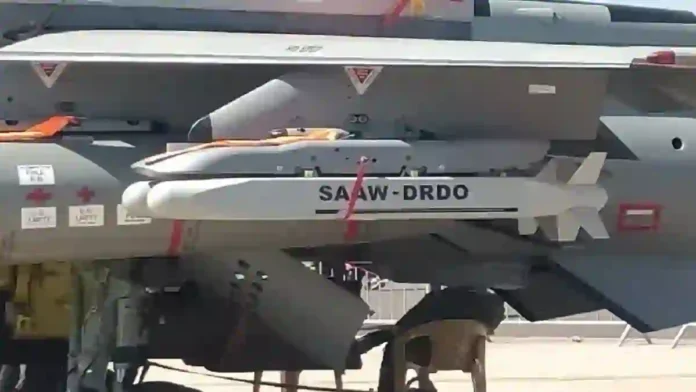India’s Defence Research and Development Organisation (DRDO) is undertaking a transformative upgrade of its indigenous Smart Anti-Airfield Weapon (SAAW), evolving it from a precision glide bomb into a jet-powered mini air-launched cruise missile with substantially enhanced capabilities.
This strategic development represents a significant milestone in India’s pursuit of advanced precision strike technologies and reflects the nation’s growing emphasis on self-reliance in critical defence systems.
Read- India’s Naval Drill Puts Pakistan On High Alert
Revolutionary Transformation With Turbojet Propulsion
The upgraded SAAW variant incorporates a compact turbojet engine and an integrated fuel tank, fundamentally transforming the weapon from a gravity-assisted glide munition into a self-propelled missile system.
This revolutionary change enables sustained powered flight throughout its trajectory, dramatically extending its operational range to beyond 200 kilometers – more than doubling the current unpowered version’s 100-kilometre capability. The integration of jet propulsion allows the weapon to maintain higher speeds and provides greater flexibility in mission planning, enabling Indian Air Force aircraft to engage targets from significantly safer stand-off distances.
The jet-powered variant will measure approximately 2.5 meters in length, compared to the standard SAAW’s 1.8 meters, with the additional length accommodating the miniature turbojet engine and supplementary fuel systems.
This extended configuration maintains the weapon’s aerodynamic efficiency while incorporating the propulsion systems necessary for extended-range operations. The development leverages DRDO’s expertise in small gas turbine technology, potentially utilising variants of existing turbojet designs developed for other indigenous systems.
Advanced Guidance And Seeker Technologies
A critical enhancement in the jet-powered SAAW is the incorporation of an advanced Electro-Optical (EO) seeker equipped with Imaging Infrared (IIR) technology. This sophisticated guidance system provides the weapon with true “fire-and-forget” capabilities, allowing it to autonomously home in on targets using visual or thermal signatures.
The IIR seeker technology represents a significant advancement over the original SAAW’s reliance purely on satellite and inertial navigation systems, enabling the missile to accurately engage both fixed infrastructure and moving targets with enhanced precision.
The electro-optical configuration enhances the weapon’s terminal guidance phase, offering real-time target acquisition and tracking capabilities that function effectively in day and night conditions, as well as adverse weather scenarios.
This advanced seeker technology has been successfully demonstrated in other DRDO systems, including the Nag anti-tank guided missile and various air defence interceptors, providing a proven foundation for integration into the SAAW platform. The imaging infrared seeker reduces the weapon’s circular error probable to less than three meters, ensuring exceptional accuracy even against time-sensitive or relocated targets.
Multi-Platform Integration And Operational Flexibility
The jet-powered SAAW is designed for integration across multiple Indian Air Force platforms, including the Sukhoi Su-30MKI, Dassault Rafale, and potentially future unmanned aerial vehicles. The Su-30MKI remains the primary launch platform, capable of carrying multiple SAAW units using indigenously developed Smart Quad Rack systems, enabling devastating salvo strikes against enemy airfield complexes.
The weapon’s compatibility with various fighter aircraft provides operational commanders with flexible deployment options and ensures the system can be effectively utilised across India’s diverse combat aircraft inventory.
The extended 200-kilometre range allows launch aircraft to remain well outside most surface-to-air missile engagement envelopes, significantly reducing pilot and platform risk during deep penetration missions. This enhanced stand-off capability is particularly valuable in contested airspace scenarios where enemy air defence systems pose significant threats to attacking aircraft. The weapon’s ability to be launched from safe distances while maintaining precision strike capabilities represents a force multiplier for the Indian Air Force’s offensive operations.
Read- Kashmir Is Not An Internal Matter of India: Pakistan’s Asim Munir Reiterates ‘Jugular Vein’ Comment
Strategic Implications And Indigenous Development
The jet-powered SAAW development underscores India’s strategic push for indigenous innovation and reduced reliance on imported weapon systems, aligning with the nation’s Atmanirbhar Bharat (self-reliant India) initiative.
The program demonstrates DRDO’s evolving capabilities in advanced munitions development and represents a significant step toward achieving technological autonomy in precision-guided weapons. The weapon’s indigenous development provides India with complete control over its specifications, production, and potential export opportunities to friendly nations.
The enhanced SAAW’s capability to neutralise enemy airfield infrastructure from extended ranges provides Indian military planners with decisive advantages in conflict scenarios. By targeting runways, aircraft shelters, radar installations, and support facilities, the weapon can effectively neutralise enemy air power before it becomes operational, potentially shaping the outcome of air campaigns from their inception. This capability is particularly relevant given India’s strategic environment and the need to maintain air superiority against potential adversaries equipped with modern air defence systems.
Timeline And Future Development
Further trials of the jet-powered SAAW are anticipated by late 2025 to validate its performance across various operational conditions, including different weather scenarios and day-night operations. The testing program will comprehensively evaluate the weapon’s enhanced range, accuracy, and reliability before transitioning to production phases. DRDO’s systematic approach to development ensures that all technical challenges are addressed before operational deployment.
The jet-powered SAAW represents part of a broader modernisation of India’s precision-guided munitions arsenal, complementing other indigenous developments such as the Rudram anti-radiation missile and various stand-off weapons currently in development.
This comprehensive approach to weapons development ensures that Indian forces will possess a diverse array of precision strike capabilities tailored to different operational requirements and threat scenarios.
The successful development of the jet-powered SAAW variant will establish India among the select group of nations possessing advanced air-launched cruise missile capabilities, demonstrating the maturation of indigenous defence technologies and reinforcing India’s position as a significant player in global defence innovation.
This achievement reflects years of sustained investment in research and development, showcasing DRDO’s evolution from a predominantly research-focused organisation to a world-class defence technology developer capable of producing cutting-edge military systems.
IDN (With Agency Inputs)
Agency




